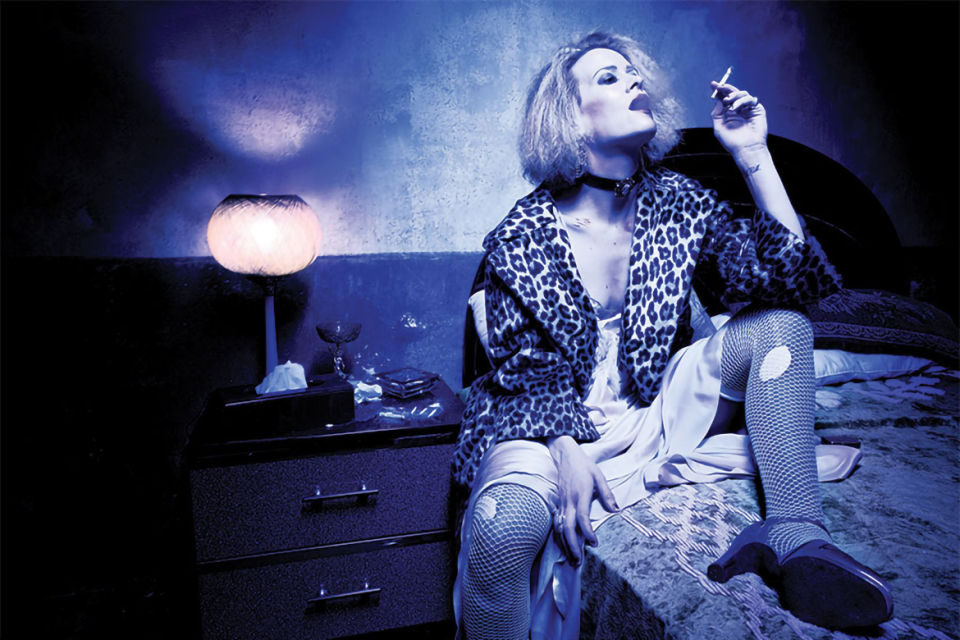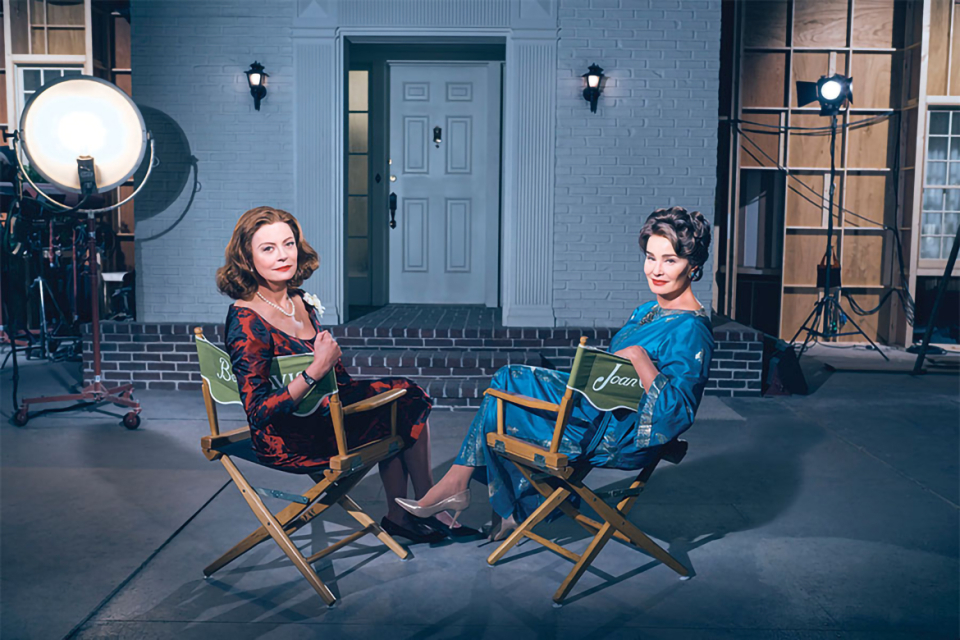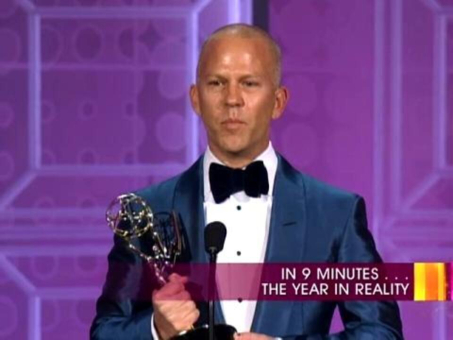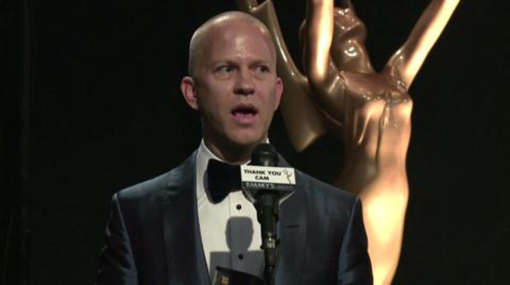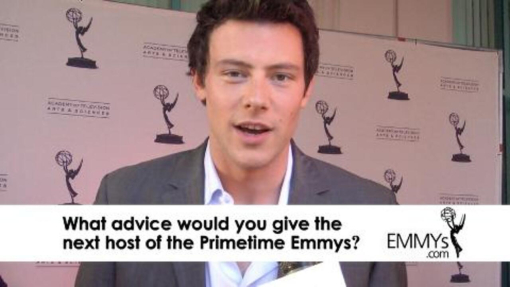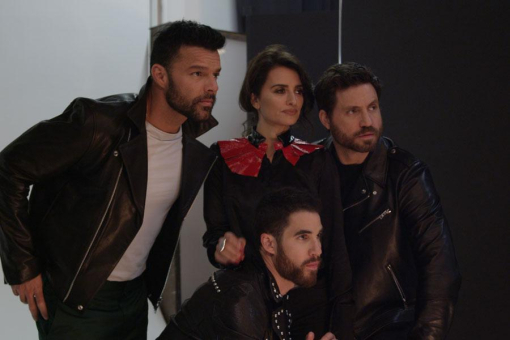As a gay teenager growing up in Indianapolis, Ryan Murphy always felt like an outsider.
And yet, even though he felt he'd never be the prom king, captain of the football team or student body president, he felt a need to fit in — on his own terms. As he told an audience at the UCLA School of Theater, Film and Television last year, "Everything I've done can be distilled down to ambition."
That ambition has led to enormous success as a creator–writer–executive producer–director of multiple television projects, including the new Pose and the American Crime Story, American Horror Story and Feud anthologies, all on FX, and 9-1-1 on Fox.
Murphy dreams big. Even as a Catholic altar boy, he didn't simply aspire to be accepted by the church. "I wanted to be the Pope," he says with a laugh. Ironically, ambition is also the Achilles' heel of most of his characters. If you don't play, you can't win. But that doesn't mean the game isn't rigged against you. Therein lies the paradox of his sensibility: outsiders determined to be insiders while remaining true to themselves.
Murphy began his writing career as a journalist, always on tight deadlines and just scraping by financially; he developed his work ethic based on basic survival. If he didn't meet his deadlines and post a story, he didn't eat.
Before he became one of the most prolific, iconoclastic, powerful showrunners in Hollywood, Murphy couldn't afford the luxury of being an outlier-provocateur. But when his first screenplay — a romantic comedy titled Why Can't I Be Audrey Hepburn? — sold right out of the gate to Steven Spielberg, Murphy got a taste of being Hollywood's "It Boy." Soon enough, however, those dizzying highs led him into the trap of Hollywood development hell.
Even though Why Can't I Be Audrey Hepburn? never got produced, it propelled Murphy into other work, including a stint on the ill-fated rom-com with a gay twist, The Next Best Thing, starring Madonna and Rupert Everett. While Murphy concedes the agony and ecstasy of working with Madonna, he knew he'd never be satisfied being pigeonholed as a rom-com writer when he'd written only one screenplay.
"You should never listen to anyone who wants to put you in a box," he reflects. He also knew that as a screenwriter of movies — a medium in which the director is king or queen — he was disposable and powerless.
It's the opposite, of course, in series television, where the showrunner calls all or most of the shots. And there, Murphy could embrace the themes that most resonated with him. His foray into television was the edgy teen soap, Popular, on the now-defunct WB network. Murphy had other options, but he gravitated toward The WB because Popular felt like a good companion piece to the network's other hits, Dawson's Creek and Felicity. Or at least that's how it looked on the surface.
But while those shows earnestly explored teen angst, Popular was designed to subvert the tropes of the coming-of-age drama series. Murphy wasn't interested in celebrating and honoring a world in which he didn't fit. A more apt title for his first series might have been Unpopular. Or Pretty Ugly. Murphy's aim was to satirize those other shows through heightened style and wry subtext. His first series taught him: tone is everything in television.
While Popular lasted only two seasons (1999–2001), it served as Murphy's crash course in not only running a writers' room, but in being a supervising producer and co-showrunner.
Coming from journalism, Murphy wanted to learn how all the moving parts of the writing and production machine coalesced. Yes, he was interested in exploring the lives of outsiders in high school, but he had other obsessions that excited his artistic soul: from casting and production design, to music choices and marketing.
He not only became a master storyteller, but also learned how to make an ambitious series on budget and on time. He learned how to fight back against Standards and Practices at The WB and realized that, if he was going to devote his life to making a series, it had better be something that affected him on a deep personal level, as seen to varying degrees in his shows Nip/Tuck, Glee, The New Normal and Scream Queens.
When Murphy's American Horror Story: Murder House premiered on FX in 2011, audiences presumed it was an edgy but "regular" series, akin to The Walking Dead. As the thrills and chills of AHS escalated and became more perverse, viewers wondered, How the hell is this show going to sustain for multiple seasons? AHS debunked that thinking at the end of season one, when everyone died and the (haunted) house burned down.
Audiences were stunned. How could that happen? Hadn't Murphy and his writing-producing partner, Brad Falchuk, written themselves into a corner? How could a haunted house–exorcism story go on with no cast and no house? Now this was groundbreaking television. Everything about this season-one finale felt wrong — except that it was all by design. The scorched-earth surprise ending was daring, diabolical and mind-blowing.
Social media exploded. Murphy had the most buzzed-about show on the air, and no one knew what could or would happen next. Was this a one- off miniseries? Or was it all just a dream? Would season two reveal that the characters were alive and ready for the next round of latex bodysuits and supernatural bloodbaths?
Like his oeuvre or not, therein lies the genius of Ryan Murphy: he provokes and tantalizes us to want more, but he never delivers what we're expecting.
Murphy both follows and sets trends the way only an outsider can: with his face pressed up against the glass. He consumes culture and programs to it in totally out-of-the-box ways.
Given that AHS airs on basic-cable, advertiser-supported FX, Murphy knew that 10 episodes would be an untenable business model for an ongoing series. After all, you don't build an audience by killing off all of the regular characters at the end of an already attenuated first season. And how many studios are likely to burn their main location down to the ground?
Murphy had to turn no into yes . The story of his life. So he came up with a new business model: the limited anthology series.
Instead of an unsustainable one-season wonder, he posited, what if AHS were the umbrella for a new form of anthology series in which each season would continue not with the same story, but on the same theme? The common denominator would be the genre: horror. The opening credits would use the same (chilling) music and (unsettling graphic) imagery. But each season would tell a new horror story set in a new city or time period.
And rather than starting over with a whole new cast, what if Murphy invited back several of the same actors in repertory fashion, akin to the films of Orson Welles, Woody Allen and Christopher Guest? They'd be playing different roles, but viewers would still be satiated with one of the staples of series television: familiarity.
It would also be fun to see such famous faces — Jessica Lange, Kathy Bates, Angela Bassett and the then up-and-coming Sarah Paulson — playing different roles. The idea of a repertory company had come and gone. "It was dead, moribund," Murphy says. "It fascinated me."
And to invigorate his blossoming mega-franchise (AHS has been picked up by FX through at least 2019), Murphy could also lean in to stunt casting. So when Jessica Lange needs a break, Lange steps out and in steps Lady Gaga in season five, AHS: Hotel.
To promote cohesion across AHS, the twitchy, Se7en-inspired title sequences all use that catchy, yet disturbing, industrial music and stylized graphics, but with different iconography for each season; these sequences are also all about setting the right tone. As Murphy explains, it's telling the audience, "This is how you're supposed to feel on a molecular level."
Murphy and his team also carefully embed Easter eggs to foreshadow not only what's to come in each new iteration of the franchise, but to also pay homage to past seasons. This provides the audience with an interactive component, a means for social media interaction, buzzy speculation of what's to come, increased suspense and controversy — all ingredients for TV success.
On the network side, the format and formula proved financially rewarding: FX could repurpose episodes on streaming services and also sell each full season into foreign markets. And Murphy had the ideal sandbox in which to play with his personal obsessions: ambition, power and outsiders looking for love and validation.
Notice the recurring theme of ambition: on AHS, even demons, ghosts, witches, cannibals and other restless spirits seek power and dominance. In Murphy's world, everybody wants to be on top.
With AHS, Murphy married the anthology format of The Twilight Zone and its 21st- century British counterpart, Black Mirror, with the once tried-and-true TV miniseries — and reinvigorated both formats into the hybridized limited-anthology series.
HBO jumped on the bandwagon with True Detective, while FX cannibalized its own format with Noah Hawley's richly satisfying TV adaptation of the Coen brothers' Fargo. I suspect we'll see more of this format for years to come.
Ryan Murphy gravitates toward seemingly impossible-to-produce projects. Case in point: his film adaptation of Larry Kramer's landmark play, The Normal Heart, which aired on HBO in 2014. Its development languished for more than 20 years as Barbra Streisand's pet project before she let the option lapse, and Murphy came to the rescue.
Every project of Murphy's is in fact his pet project, but this was his most personal, because it dealt with the devastation within the gay community from the AIDS epidemic. Murphy survived, but the losses and impact on his life were immeasurable. "I never expected to live past 32," he offers. This void has fueled his sense of urgency to tell the stories he most needs to; he understands that time is fleeting and that every day matters.
Most writers and directors in Hollywood work as outsiders until they achieve enough clout to become insiders. But Murphy's unprecedented success has come from embracing his outsider status. What is arguably his greatest career achievement to date, The People v. O.J. Simpson: American Crime Story, came to fruition when, after six seasons of Glee, Murphy asked his longtime agent, Joe Cohen at CAA, to send him the best projects he'd ever read that couldn't seem to get made.
When he first read the title page of a script by Scott Alexander and Larry Karaszewski, Murphy rolled his eyes and thought, "No way. Anything but O.J." Alexander and Karaszewski had written the first two episodes based on the bestselling nonfiction book by Jeffrey Toobin. Despite the involvement of powerhouse producer Nina Jacobson, The People v. O.J. Simpson had never been produced. As Murphy recounts, "I love the feeling of championing a project that seems impossible."
Despite his disinterest in reopening the O.J. trial, Murphy was quickly hooked by the material. Not because it reinforced what he already knew, but because he discovered new things. What jumped out at him was the central role not of O.J., but of the outsider: Marcia Clark (Sarah Paulson, who won an Emmy for her portrayal). Murphy saw Marcia as his way into the story: "I understood her. She was an outsider, a woman surrounded by straight, white condescending men."
Murphy wasn't interested in the rise and fall of O.J. He was interested in the race issues and the misogyny. He wanted Marcia Clark to be the lead and also to depict the other attorneys on the case, but with greater dimension. He wanted viewers to reflect on the characters and gain a deeper perspective on the case — that was a given. But what elevated this true-crime story into its own genre was, once again, tone.
Just as he had satirized teen-angst tropes on Popular, Murphy knew from the get-go that he wanted to tonally explore this landmark trial as a satire. Stylistically, his greatest influence in this project was Network, the Paddy Chayefsky– Sidney Lumet 1976 masterpiece.
Murphy also knew it was time for him to demonstrate his maturity and confidence as a director. He began this new approach when directing The Normal Heart. Instead of showy camera work, he opted for a more cinema-vérité style. If he'd been criticized for cinematic acrobatics, of showing off to prove his prowess, he now simplified. "I never move the camera anymore. Ever." By not trying so hard, he found critical acclaim and mainstream acceptance.
It should also be noted that, once Murphy decided to make The People v. O.J. his next project, he had to campaign for the job. He wanted to do 10 episodes and "cast the shit out of it." But it was an uphill battle. And despite all the acclaim that the series has since received, Murphy says he is confused by its success. "I never understood it. I still don't."
As for casting John Travolta as attorney Robert Shapiro, Murphy was inspired by Billy Wilder's Sunset Boulevard, in which William Holden played Joe Gillis, the drowned screenwriter narrating his own story from the bottom of Norma Desmond's swimming pool. Murphy enjoys casting actors who have fallen off the Hollywood radar in principal roles, and he "just knew" that Travolta would make the perfect Shapiro.
To convince the network brass, Murphy paid Travolta's salary out of his own pocket and gave up some of his back-end points. When using big-name actors in real-life roles, he encourages his performers not to imitate but to "find the essence of the person." When an actor impersonates, Murphy reasons, he tends to lose the emotion. "And emotion is everything."
Murphy continues to expand his empire with the American Crime Story franchise: this year's The Assassination of Gianni Versace — starring Darren Criss, Penélope Cruz, Ricky Martin and Edgar Ramírez — allowed him to explore a social crime involving homophobia. And with Pose [which debuted June 3 on FX], Murphy has made history with the largest cast of transgender actors.
But rather than creating a documentary, à la Making a Murderer on Netflix and The Jinx on HBO, Murphy shapes true-life stories through his own fisheye lens.
"I never consciously think about social activism," he says. "My work just contains themes that are important to me." And when structuring the dramatic narrative of a true tale, Murphy relies on theme. He adds layers to the story, not just plot. His approach as writer-creator is the same as a director: to establish tone, he needs to know his first and last shot.
It's probably not surprising that Murphy makes vision boards and obsesses over minute details. He notoriously spent two days choosing the right fish for the aquarium in the Nip/Tuck doctors' office. He also gets engrossed in color palettes and design elements. Being a showrunner is the ideal job for him because he loves making taste-based decisions and delegating to his team — all in the service of tone.
In Feud: Bette and Joan, about the rivalry between Bette Davis and Joan Crawford during the making of the cult movie Whatever Happened to Baby Jane?, Murphy was not interested in doing camp.
Instead, "I was interested in the idea of a career being over by age 52" (Murphy's age when the series premiered). He wanted to explore female competition and how some women tend to undermine each other instead of uniting. The first installment of Feud is, in Murphy's words, "a horror show about inequality," a feeling all too familiar to outsider Murphy.
The next installment of Feud will focus on Princess Diana and Prince Charles. "My way into the story is Diana, an outsider trying to navigate a system of expectations," Murphy says. He can relate to Diana and muses aloud about her situation: "Should you stay in this marriage for duty and your love for your kids even though your husband is in love with another woman?"
His approach is less about the chronology and more about what Diana was like as a person. Murphy has an unlimited supply of famous feuds from which to draw for future limited seasons.
How's that for another paradox: the unlimited limited series? But leaning in to what no one else seems to want — outlier, orphaned, fringe projects — keeps Murphy flying high. "You can't win anymore by being mainstream, with something for everyone," he asserts. "Everyone wants niche."
His landmark overall deal with Netflix commences this summer. Possibly influenced by Disney's proposed acquisition of 21st Century Fox and what this might mean for his shows, Murphy may have opted for more certainty at Netflix — and a deal worth a reported $300 million.
"The history of this moment is not lost on me," Murphy said in February, when the decision was announced. "I moved to Hollywood in 1989 with 55 dollars in my pocket, so the fact that my dreams have come true in such a major way is emotional and overwhelming to me. I am awash in appreciation [to] Netflix for believing in me and the future of my company, which will continue to champion women, minorities and LGBTQ heroes and heroines, and I am honored to continue my partnership with Fox on our existing shows."
Those shows include Pose. I can't wait to see what the rebel does next.
Excerpted with permission from TV Writing on Demand: Creating Great Content in the Digital Era ©2018 Neil Landau, published by Routledge.
This article originally appeared in emmy magazine, issue No. 7, 2018


